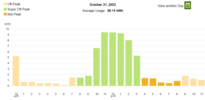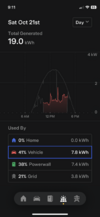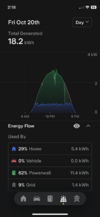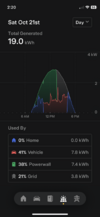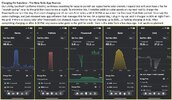Hello, I have a Model Y and a Powerwall 2. I've been using Charge on Solar and it seems to work properly in the app, but I'm still being billed by my electric company, as if it is not "excess solar" but just coming from the grid. What gives?
Welcome to Tesla Motors Club
Discuss Tesla's Model S, Model 3, Model X, Model Y, Cybertruck, Roadster and More.
Register
Install the app
How to install the app on iOS
You can install our site as a web app on your iOS device by utilizing the Add to Home Screen feature in Safari. Please see this thread for more details on this.
Note: This feature may not be available in some browsers.
-
Want to remove ads? Register an account and login to see fewer ads, and become a Supporting Member to remove almost all ads.
You are using an out of date browser. It may not display this or other websites correctly.
You should upgrade or use an alternative browser.
You should upgrade or use an alternative browser.
Charge on solar, still being charged by electric company?
- Thread starter Brett Roble
- Start date
wwu123
Active Member
If you were previously always conscientious to charge your EV during off-peak hours, then all Charge on Solar does is time-shift your charging from one off-peak period (probably late night) to another off-peak period (late morning). Since everyone in California is currently either on NEM1 or NEM2, at best what you save from your electric bill might be some non-bypassable charges, which are on the order of $0.02-0.03 per kwh typically.Hello, I have a Model Y and a Powerwall 2. I've been using Charge on Solar and it seems to work properly in the app, but I'm still being billed by my electric company, as if it is not "excess solar" but just coming from the grid. What gives?
Because before Charge on Solar, you were exporting your excess solar and getting close to full retail credit (which you were then using later to charge your Model Y). So there's not much savings, just a feel-good...
I guess my understanding is that it used excess solar to charge the car, so re-routing solar that would have been sent to the grid to the car instead. Is that not correct?
@wwu123 explained this better than I could. Its not that your understanding is incorrect. Its just that its unlikely you would be saving any real money if you were charging your car at night during off peak time, and exporting your solar to the grid during the day.
Redhill_qik
Active Member
The graph saysI guess my understanding is that it used excess solar to charge the car, so re-routing solar that would have been sent to the grid to the car instead. Is that not correct?
- Home = 0% and 0kWh
- Vehicle = 41% and 7.8 kWh
- Powerwall = 38% and 7.4 kWh
- Grid = 21% and 3.8 kWh
That's weird. The image shows blue on the chart that energy went to the house, but it shows 0%. On days that I didn't charge the car it displays properly.The graph says
Seems like you have a problem with how your system is measuring home usage.
- Home = 0% and 0kWh
- Vehicle = 41% and 7.8 kWh
- Powerwall = 38% and 7.4 kWh
- Grid = 21% and 3.8 kWh
Attachments
Is your Wall Connector backed up by your Tesla gateway? If not, is it monitored separately with an additional CT? Charge on Solar subtracts the vehicle usage from the home usage to make the accounting work; however if the car charger load is not monitored by Tesla, the numbers will be wrong in the app.
h2ofun
Active Member
For me, my wall connectors are not behind the gateway, no CT's, so I just do it manually each day.Is your Wall Connector backed up by your Tesla gateway? If not, is it monitored separately with an additional CT? Charge on Solar subtracts the vehicle usage from the home usage to make the accounting work; however if the car charger load is not monitored by Tesla, the numbers will be wrong in the app.
wwu123
Active Member
Maybe the more illustrative way to explain it is the converse example - that Charge on Solar will be extremely valuable to folks in California installing solar now, basically those who will be on NEM3 from the get-go. On NEM3, excess solar exported to the grid is essentially worth nothing to the end-user (there's some complex transitional periods and some wholesale credits, but in the long run the statement is pretty true), so it would be far better to consume it behind-the-meter by putting it into the car instead.@wwu123 explained this better than I could. Its not that your understanding is incorrect. Its just that its unlikely you would be saving any real money if you were charging your car at night during off peak time, and exporting your solar to the grid during the day.
But not needed for those who get retail credit for exports, which is the whole point of net metering (NEM1/NEM2), you've banked the excess production as credits for use later.
If you can manage the bulk of your charging on CoS, the 3-4000kWh/yr might add up to $120 saved a year in avoided NBCs. It's a small optimization but if you have the hardware anyhow, why not? For the green motivated folks, it shifts more power consumption to the periods with excess solar meaning less during the evening when presumably clean sources are less abundant.If you were previously always conscientious to charge your EV during off-peak hours, then all Charge on Solar does is time-shift your charging from one off-peak period (probably late night) to another off-peak period (late morning). Since everyone in California is currently either on NEM1 or NEM2, at best what you save from your electric bill might be some non-bypassable charges, which are on the order of $0.02-0.03 per kwh typically.
Because before Charge on Solar, you were exporting your excess solar and getting close to full retail credit (which you were then using later to charge your Model Y). So there's not much savings, just a feel-good...
wwu123
Active Member
I totally hear ya! Every month I'm wasting time playing around with small efficiency things to see if I can shave a few $ of my PG&E consumption/bill, so $10/month is nontrivial IMO. But the savings on NBC's are <10% of the actual charging costs, and apparently not meaningful for the OP to notice.If you can manage the bulk of your charging on CoS, the 3-4000kWh/yr might add up to $120 saved a year in avoided NBCs. It's a small optimization but if you have the hardware anyhow, why not? For the green motivated folks, it shifts more power consumption to the periods with excess solar meaning less during the evening when presumably clean sources are less abundant.
That said, if one is driving 10-20K miles a year to use that much charging, a good bet one is commuting to the workplace multiple times/week, so car will not be at home to leverage CoS on said days...
That's a fair point. I'm mostly working from home but with 2 cars and weekends, still managing about $5/mo savings with CoS. My solar is WNW facing so there's not much excess this time of year regardless but I think we could do a bit better if I could convince my wife to plug her car in every day. In the summer months, she could commute all week and then use CoS to fill up on the weekends.
swedge
Member
I had the same situation. My wall connector is connected between the utility meter and the gateway. The gateway has current transformers which sense the power coming from or to the grid. Since my car was charging outside of what the gateway could see, car charging was not included in the Powerwall data. That was until Charge on Solar came out. Now the PW does know about car charging but it still does not see that draw from the grid, so it screws up it's own measurements.That's weird. The image shows blue on the chart that energy went to the house, but it shows 0%. On days that I didn't charge the car it displays properly.
I believe this was an oversight on Tesla's part, and that PW could figure this out and keep it's data straight. I wrote this up and submitted a bug report/suggestion. Maybe, someday, they'll fix it. I'd suggest you call Tesla Energy Support and ask them to explain, and then encourage them to fix their CoS software.
In the mean time there are a few fixes. Easiest is to turn off Charge on Solar in the app and forget about the minor savings. Or, you could still accomplish the same thing manually, by monitoring your PW and adjusting car charging to match the exported solar. I used to do that, but it is a pain to monitor and adjust all the time. Some have reported using third party software and/or API scripts running on a home computer or Pi, to monitor the PW and adjust the car charging. Alternatively, you could rewire your wall connector to be backed up by the PW, which makes the car charging included in the what the gateway see coming from the grid. What I did was I bought 2 new current transformers, put the on the wires from the meter to the main breaker, and connected them to the gateway substituting for the internal ones. Parts and tools cost less than $100, but working inside the main breaker box requires familiarity and caution. (My installer wanted $300 just to "diagnose" the problem which I had already diagnosed, not an unreasonable fee for a tech to drive out, but I suspect their tech would not understand the simple fix anyway.)
My true-up adjustment was all of ~$67 this year, and I am trying to wring every cent out that I can this year. Charging the car on solar (rather from the grid) will save me only a few bucks this year, but even those few bucks will be a significant fraction of that small year-end bill.
Ed Hart
Member
Similar threads
- Replies
- 1
- Views
- 337
- Question
- Replies
- 0
- Views
- 157



